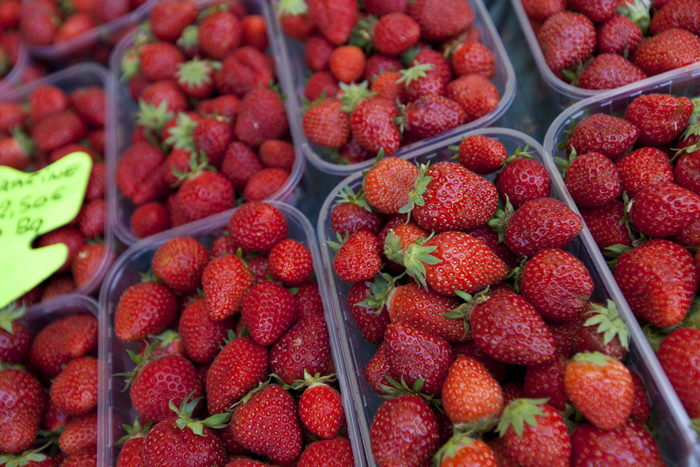
WholeFoods Magazine
The Dirty Dozen Revisited

With widespread consumer concerns regarding mandatory GMO labeling and legislation to support the endeavor, consumers and natural products manufacturers may be ignoring or overlooking the importance of choosing certified organic to avoid exposure to harmful pesticides. Every year, the Environmental Working Group (EWG) creates a Shopper's Guide to Pesticides in Produce. For consumers and manufacturers committed to safe pure food, pesticide residues are not to be ignored. The EWG's shoppers guide ranks pesticide contamination based on an analysis of more than 35,200 samples taken by the U.S. Department of Agriculture (USDA) and the U.S. Food and Drug Administration.
Organophosphate pesticides are nerve agents developed for warfare that should be banned. The federal Food Quality Protection Act of 1996 mandated that the U.S. EPA improve its regulation of pesticides and reduce the risk of pesticide exposure for children because such substances are powerful neurotoxins. Even in low doses they have been found to impair children's intelligence and brain functioning. Studies on prenatal pesticide exposure reveal a substantial decline in cognitive skills in children living in proximity to agricultural fields and in urban dwellings. In addition to pesticides ingested through non-organic food consumption, pesticide exposure on suburban lawns, golf courses and school playgrounds also pose serious concerns.
Pesticides and insecticides including chlorpyrifos, acephate, oxymeyl, famoxadone, diedrin, DDE and esfenvalerate as well as carbamate are highly toxic and should be strictly avoided. Continuing research has demonstrated that favoring a certified organic diet resulted in a measurable decline in pesticide residues commonly found in test subjects urine. Interestingly, consumers who eat organic produce ingest fewer pesticides, even though they may consume 70% more fruits and vegetables than subjects reporting that they rarely or never purchase organic produce.
The Dirty Dozen and Clean Fifteen
According to the Environmental Working Group, nearly three-fourths of the 6,953 fruit and vegetable samples tested by the USDA in 2015 contained pesticide residues, despite consumer demand for food without synthetics or chemicals. In addition, the USDA tests found a total of 146 different pesticides in thousands of fruit and vegetable samples. These pesticides had a persistent presence on the produce samples even when washed or in some cases, even when the fruit and vegetable samples were peeled.
This year's list of the fruits and vegetables highest in pesticide residues includes strawberries, apples, nectarines, peaches, celery, grapes, cherries, spinach, tomatoes, sweet bell peppers, cherry tomatoes and cucumbers. The EWG findings also confirmed that more than 98% of strawberries, peaches, nectarines and apples sampled tested positive for at least one pesticide residue and that a single grape and sweet bell pepper samples contained 15 pesticides. Single strawberry samples contained 17 different pesticides.
The Clean Fifteen listed at the end of the EWG list includes avocados, sweet corn, pineapple, cabbage, frozen sweet peas, onions, asparagus, mangoes, papayas, kiwis, eggplant, honeydew melon, grapefruit, cantaloupe and cauliflower. According to the EWG, relatively few pesticides were detected on these foods and no single fruit sample from the Clean Fifteen tested positive for more than four types of pesticides. The research also highlights potential GMO varieties on the shelves—which include sweet corn, Hawaiian papaya and summer squash (zucchini and yellow squash)—with a strong recommendation to buy certified organic to avoid GMOs. Gene-silenced potatoes and apples are also a recent consumer concern. For manufacturers and consumers wishing to source safe, health-promoting foods and ingredients, choosing 100% certified organic cannot be overemphasized.
You can view the complete list of 50 fruits and vegetables reviewed for pesticide residues at https://www.ewg.org/foodnews/list.php.
References
Bouchard M, Chevrier J, Harley K, et al. 2011. Prenatal Exposure to Organophosphate Pesticides and IQ in 7-Year Old Children. Environ Health Perspect 119(8): 1189–1195.
Curl CL, Beresford SAA, Fenske RA, et al. 2015. Estimating Pesticide Exposure from Dietary Intake and Organic Food Choices: The Multi- Ethnic Study of Atherosclerosis (MESA). Environmental Health Perspectives. Advanced publication February 5, 2015. DOI: 10.1289/ ehp1408197 http://ehp.niehs.nih.gov/wp-content/uploads/advpub/2015/2/ehp.1408197.acco.pdf
Engel SM, Wetmur J, Chen J, et al. 2011. Prenatal Exposure to Organophosphates, Paraoxonase 1, and Cognitive Development in Childhood. Environ Health Perspect 119(8): 1182-1188.
Rauch SA, Braun JM, Barr DB, et al. 2012. Associations of Prenatal Exposure to Organophosphate Pesticide Metabolites with Gestational Age and Birth Weight. Environ Health Perspect. 120(7): 1055–1060.
Rauh V, Arunajadai S, Horton M, et al. 2011. 7-Year Neurodevelopmental Scores and Prenatal Exposure to Chlorpyrifos, a Common Agricultural Pesticide. Environ Health Perspect. 119(8): 1196-1201.
Simi Summer, Ph.D. is an organic advocate, independent researcher, educator, and freelance writer. She is a strong proponent of organic consumer education and informed consumer choices.
NOTE: The opinions expressed in bylined articles are not necessarily those of the publisher.
Posted on WholeFoods Magazine Online, 4/22/2016







